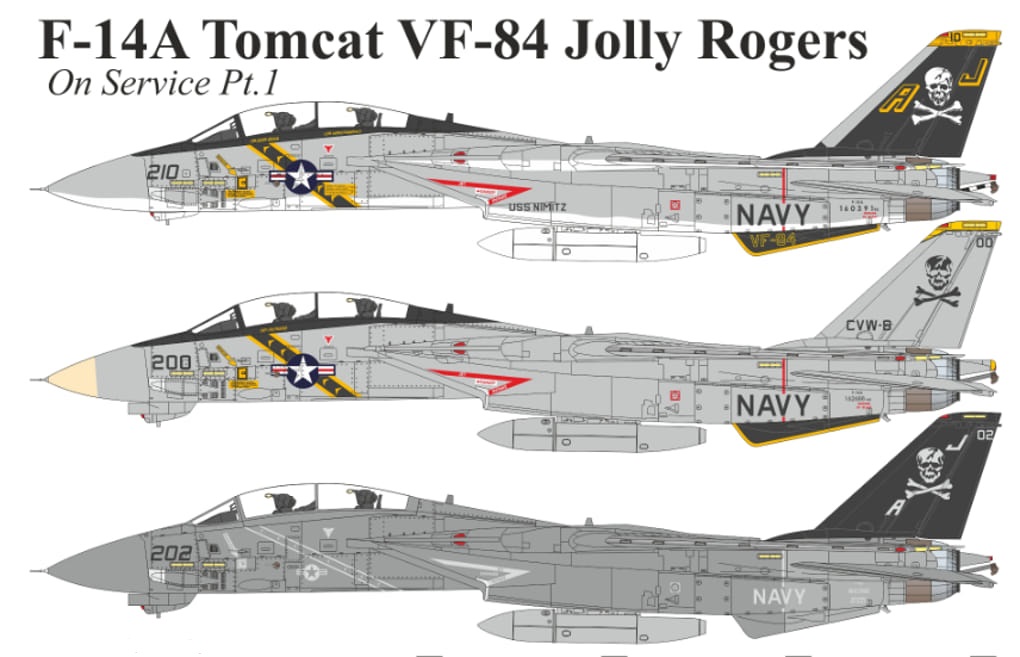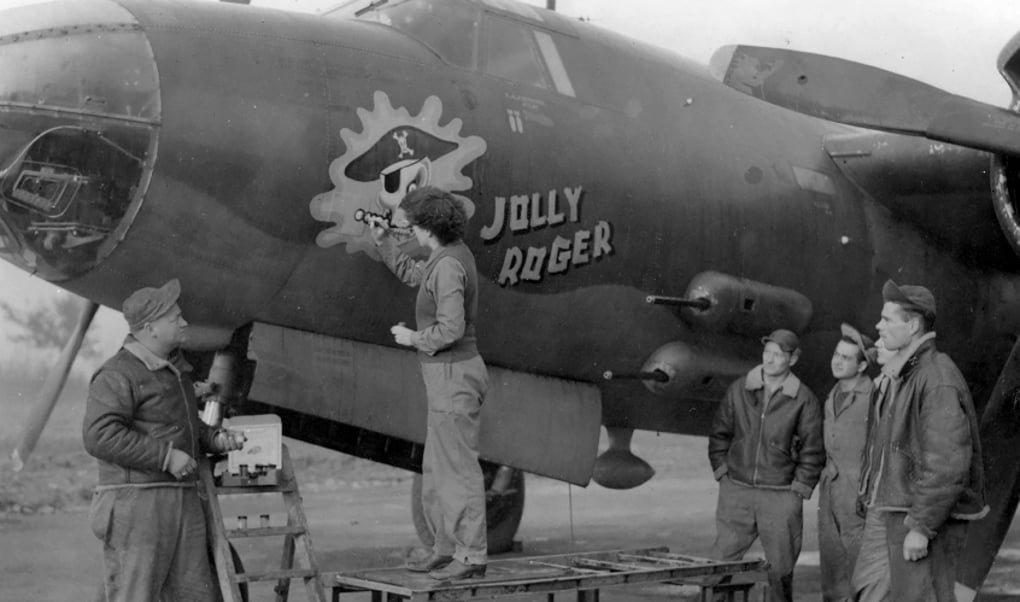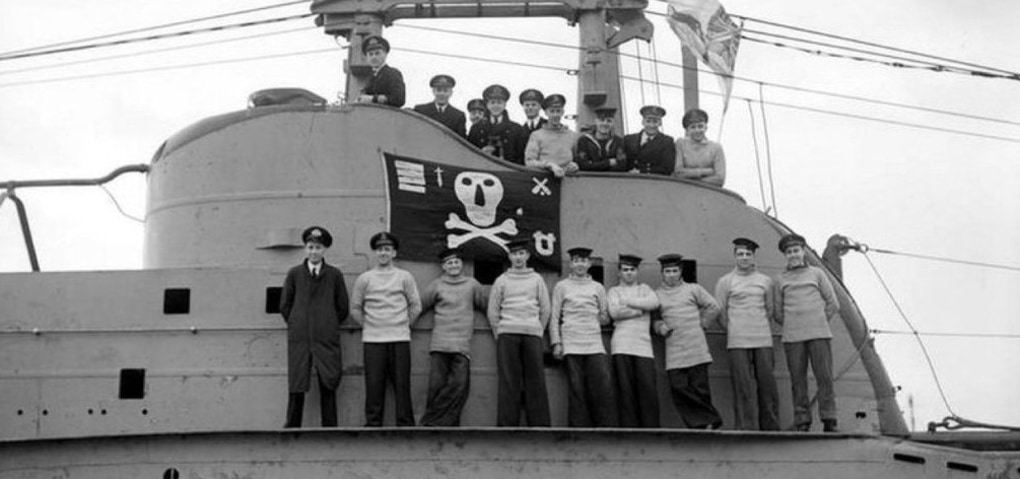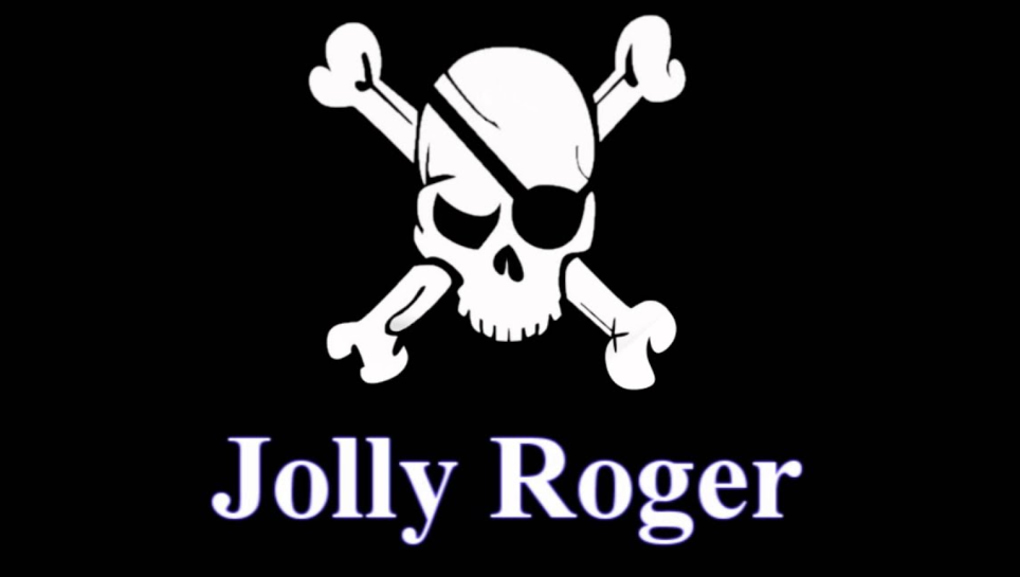The 90th Bombardment Group, referred to by their famous nickname “Jolly Rogers,” was a very important squadron during World War II.
The Jolly Rogers were known for having some of the bravest and most skilled aircrews during World War II. Their planes carried a skull and crossbones symbol, representing their fearless attitude.
One of the most daring crews flew the B-24 Liberators. These bombers were key in attacking Japanese forces in the Pacific Theatre, especially in New Guinea and the Philippines. Their missions helped disrupt the enemy and were important in the giant fight against Japan.
In this Info article, we are going to trace the history of the Jolly Rogers and learn about their lives and why their service is still celebrated today.
The Jolly Rogers: A Brief Background
Jolly Roger was among the first B-26 bombers in the 556th Bomb Squadron. Jolly Rogers was technically the 90th Bombardment Group (BG), a Fifth Air Force unit of the U.S. Army Air Forces.
They were activated in April 1942 and have become famous for flying the B-24 Liberator, the heavy bomber. For its part, the Jolly Rogers released their bombs on Papuan New Guinea, Philippines, and other territories in the Pacific to force the Japanese back.
One special marking of the Jolly Rogers aircraft was the mark on the planes. Their tail had a skull and crossbones marking, which is like any pirate flag, sending the same fear into enemy forces and boosting the crews’ morale.

About Jolly Roger:
Name: Jolly Roger
Nickname: Shady Lady II
Aircraft Model: Martin B-26B-20-MA Marauder
Serial Number: 41-31682
Squadron Code: FW-N
Missions Flown:
- First Mission: July 31, 1943
- Last Mission: February 15, 1944
- Total Missions: 40
- Crew Chief: T/Sgt. Odies Gover
Assistant Crew Chief: Cpl. Earl Hoffman
The original crew, which flew the plane from the United States to England, included:
| Position | Rank | Name |
| Pilot | 1st Lt. | Stephen S. Adams |
| Co-Pilot | 2nd Lt. | Weldon J. Allen |
| Bombardier/Navigator | 2nd Lt. | Richard C. Moffet |
| Engineer/Gunner | S/Sgt. | Ben D’Alessio |
| Radio Operator/Gunner | T/Sgt. | Richard F. Palmer |
| Aerial Gunner | Pvt. | Wilbur T. Beck |
The plane was accompanied by Flight Chief T/Sgt. John W. Gorski during the flight to England.
If you’re interested in learning more, click the link dive deeper into the details: crewdaily.com
Final Mission:
On February 15, 1944, Jolly Roger (then renamed Shady Lady) was on a mission over La Glacerie, France, targeting a German V-1 missile site. The plane was hit by enemy flak and crashed near Le Theil, France. Sadly, several crew members died, while others faced different fates:
| Status | Position | Rank | Name |
| KIA | Pilot | 1st Lt. | Thomas L. Alford |
| KIA | Co-Pilot | 2nd Lt. | Winston W. Hunt |
| KIA | Bombardier/Navigator | 1st Lt. | Michael G. Koury |
| POW | Engineer/Gunner | S/Sgt. | Robert M. Arthur |
| KIA | Radio Operator/Gunner | T/Sgt. | Clyde M. Lawrence |
| POW | Aerial Gunner | S/Sgt. | Clarence E. Dalrymple |
The plane was seen on fire before crashing. Only Sgt. Arthur and Sgt. Dalrymple managed to escape by parachute. Lt. Hunt, though seriously injured, died a few days later. The other three crew members lost their lives in the crash and were buried in Cherbourg, France. Sgt. Arthur was captured, while Sgt. Dalrymple initially evaded capture but was later caught in Paris.
Visit Also: CATM (Combat Arms Training and Maintenance)

Key Crews and Their Duties
Each bomber of B-24 had around ten men in its crew, including a pilot, co-pilot, navigator, bombardier, engineer, radio operator, and gunner. The planes carried men from all walks of life and states across U.S.A. They forged strong bonds during intense training and combat experiences. Here are some of the critical roles on board:
- Pilot and Co-Pilot: The pilot managed the whole operation. He maintained the plane on course, safe for the crew. He was relieved by a co-pilot and divided control during long-duration flights.
- Navigator: The navigator used maps, charts, and other instruments to guide the bombers across a huge expanse of the Pacific so that they landed on target.
- Bombardier : This was to successfully drop bombs at the target. This was an extremely crucial feature if the bombing was wrong and they missed critical items.
- Engineer and Radio Operator: Engineer kept an eye on his engines, fuel, and other aspects that could make his plane perform badly, while he had the radio operator send a message from his crew to his command center for reporting issues and receiving commands.
- Gunners: The B-24 was fitted with numerous .50-caliber machine guns. Every gunner was assigned to a specific area to provide protection. Their purpose would be to protect the bomber from enemy fighter attacks, always on the minds of the crew during any mission.
Read More: U.S. Navy Jets to fly over former President George H.W. Bush Funeral
Notable Members of the Jolly Rogers
It is impossible to find a complete crew list for each mission, but some individual names become legendary in the annals of Jolly Rogers. For example:
- Lt. David Lankford was among the few manning a B-24 called “Dinky.” He flew over a number of completed missions, and his bravery and dedication were remembered by his squadron.
- Colonel Paul I. “Pappy” Gunn: He is recognized as one of the great mechanics and inventors of the Pacific War. He changed the B-24s that had been dispatched to the Jolly Rogers. He added a turret gun over the nose of the airplane; the planes have additional firepower, which really improved combat effectiveness.
- The “Double Trouble” crew There was another infamous plane called the Jolly Rogers called the “Double Trouble”. Its crew would make dangerous passes over enemy territory where heavy anti-aircraft fire and enemy fighters often lay in wait.

Jolly Rogers (VF-84) Crew List
This list shows the names of sailors who served in the Jolly Rogers (VF-84) squadron—only the names of those who submitted their information.
Read Also: Justin Moreland F-16 A Fighter Pilot
Select the Period (starting by the reporting year): Precomm – 1984 | 1985 – Now
| Name | Rank/Rate | Period | Remarks/Photo |
| Keck, Gary | Pn3 | 1962 – 1964 | Remembered cold nights on the flight deck, liberty in Cannes, rough waters in Naples, and squadron parties. |
| Pummill, Darrel Dub | AMS3 | Feb 28, 1962 – Mar 15, 1964 | Recalled friendships in the airframes shop. |
| Rolstad, Jack | AME3 | Mar 3, 1962 – Apr 1, 1964 | Retired from VR 51, NAS GLNW in 1987; looking for old friends. |
| Echols, Ros | AA TO A03 | Aug 2, 1962 – Jan 13, 1964 | First command after boot camp, involved in Cuban Missile Crisis. Retired as CPO in 1982. |
| Morse, Bruce | AN —- ADJ-3 | Sep 1963 – 1965 | Worked in Maintenance Records and later in the engine shop with F4 Phantoms. |
| Lysett, Andy (Kid) | adj 2 | 1964 – 1967 | |
| Medeiros, Ron | AMSAN | 1965 | Line Rat during the West Pac; medically retired after car accident in 1969. |
| Gibbs, Robert (Hoot) | ADJ 3 | 1965 – 1966 | Reminisces of West Pac memories and life since. |
| Marshall, Ed | AO3 | Apr 1965 – Feb 1966 | Served with various fellow Jolly Rogers; retired in 1983. |
| Barfield, Paul | AE | Apr 12, 1965 – Aug 2, 1967 | Line Rat in West Pac 1965; looking to reconnect with others. |
| Buonovolonta, Otto | E3 | Nov 22, 1965 – Oct 1967 | Served aboard VF-84 with unforgettable experiences. |
| Cohen, Jules | PR 3 | Jan 13, 1966 – Dec 1967 | Time in the Navy and on CVA 62 was memorable. |
| Castete, Don | AE2 | Nov 1968 – Dec 1971 | Completed two cruises on the Rosey Boat. |
| Logan, Ronald | AE 4 | Oct 14, 1969 – Dec 15, 1972 | Worked as flight deck checker and troubleshooter. |
| Bleakley, Frank J | ADJ-3 | Nov 15, 1969 – Aug 26, 1972 | Recalls his first crossing of the Bay of Biscay. |
| McDougall, Gordon | HM1 | 1971 – 1973 | Squadron Corpsman |
| Fincher, David | AN | Jan 15, 1971 – Apr 20, 1973 | |
| Dalton, Michael | Airman | Apr 12, 1971 – Apr 2, 1975 | Served in S-1 and S-3 Divisions, completed 1972 cruise. |
| Dalton, Mike | AK3 | Apr 12, 1971 – Apr 2, 1975 | Still kickin’ |
| Fortner, Richard | ADJ2 | Oct 1, 1971 – Feb 2, 1973 | Experienced the year-long cruise. |
| Fornal, J | AME 1 | Mar 1973 – May 1985 | |
| Schellang, Carolyn | AMS2 | 1974 – 1976 | Announces passing of husband, George E. Schellang, who served with VF-84. |
| Schellang, George (Eddie) | AMS-2 | Jun 1974 – Jul 1976 | Remembers Jolly Rogers as the best crew ever. |
| Atcherley, Bill | AO3 | Aug 5, 1974 – Feb 14, 1979 | Worked with F-4 Phantoms and F-14 Tomcats; great camaraderie. |
| Royce, Dave | AME3 | 1975 – 1978 | |
| Napier, Johnny (Nape) | AMH-2 | Jun 6, 1975 – Jul 9, 1977 | Seeking fellow VF-84 members from 1974-78. |
| Gerda, Robert (Heebee) | AD2 | 1976 – Sep 7, 1979 | |
| Baldonado, Joseph Nick | MS3 | Apr 1976 – Nov 1977 | Honor to serve with VF-84 Fighter Squadron. |
| Mills, Glenn | AT E5 | 1977 – 1980 | |
| Gier, Roger | AO1 | Aug 24, 1977 – Apr 18, 1988 | |
| Zimmerman, Roy | E5 | Feb 1978 – Feb 1982 | |
| Robbins, Bruce/abs | E5 | Nov 1, 1978 – Jun 4, 1982 | Continued in aviation with the FAA. Looking to reconnect. |
| Lambertsen, Lamb | AMH-3 | May 8, 1979 | Reconnected with squadron friends and attended recent reunion. |
| Otis, Alan | AME | Jul 1979 – Aug 1981 | Experienced the Final Countdown; “Gonzo” for 144 days. |
| Schoenthaler, David | AT3 | Sep 3, 1980 – Jul 7, 1982 | |
| Buffenbarger, Garry | Ae2 | Mar 1, 1981 – May 31, 1984 | Flight deck troubleshooter for VF-84 CAG 8. |
| Hudson, Mark | E4 | Apr 4, 1982 – May 27, 1984 | |
| Mitchell, Patrick | AO3 | 1983 – 1985 | Acknowledges Master Chief Petty Officer of the Navy Fitzgerald. |
| Stover, Paul | PN2 | Mar 1983 – Mar 1985 | Remembers photos and plaques from his time with VF-84. |
| Butterfield, Bob | AT3 | May 1, 1984 – Jun 1, 1987 | Proud to have served with VF-84; maintains friendships today. |
| Street, Thomas | AT1 | Sep 10, 1984 – Jun 6, 1986 | Fond memories of the command; considers it the best time of his life. |
Jolly Rogers Navy
The Jolly Rogers is a name that has a long history assigned to more than a few US Navy fighter squadrons. Perhaps the most famous is the VF-17, which flew in WWII and is associated with the skull-and-crossbones insignia. The VF-84 also flew under this name and flew the F-14 Tomcat from the early 1980s into the late 1990s. Both were distinguished fighting squadrons.
Read More: Jet Bridge “Jetway Passenger Boarding Bridges“ A Comprehensive Overview

Jolly Roger Flag
The Jolly Roger flag tells the world that it contains a skull and crossbones to symbolize being a pirate flag. It let the world know that the pirates always prepared to fight and would never take any hostages. Today, this represents opposing concepts of power and disrespect. This flag is assumed by the military and the U.S. Navy’s Jolly Rogers squadron.

F-14 Jolly Rogers
This highly used U.S.t fighter in operations catapulted the Jets to fame through the wonderful movie Top Gun, where they featured. They stopped flying the F-14 Tomcat towards the late 1990s and opted for the F/A-18 Hornet. The Jolly Rogers squadron flies the F-14 Tomcat between the 1970s and the 1990s.
Must Visit: F 35b Fighter Jet Pilot Ejects After Loosing Control
Final Thoughts
The Jolly Rogers, with their bold emblem and daring spirit, have a special place in World War II history. The courage and skill of these men helped secure victory in the Pacific and showed the world the strength of the American airmen. For those interested in learning more, visiting online archives or exploring veterans’ stories can provide a deeper appreciation of what these heroes achieved.
FAQs
What was the Jolly Rogers squadron’s job during WWII?
The Jolly Rogers, in other names called as VF-84, was a fighter squadron of the United States Navy. It was in fact carrying out flights with aircraft and bombing enemy targets in France and the Mediterranean and offering air support during critical battles.
How many missions did the “Jolly Roger” plane fly?
The plane “Jolly Roger” flew 40 missions during its service. These missions were dangerous bombing runs over enemy areas.
What happened to the plane after its last mission?
On February 15, 1944, the plane was shot down over France during a mission. It caught fire and crashed near a village called Le Theil. Some of the crew members died, and others were taken as prisoners of war.
Who was on the plane during its last mission?
The crew during the final mission included:
- 1st Lt. Thomas L. Alford (Pilot)
- 2nd Lt. Winston W. Hunt (Co-pilot)
- 1st Lt. Michael G. Koury (Bombardier)
- S/Sgt. Robert M. Arthur (Engineer)
- T/Sgt. Clyde M. Lawrence (Radio Operator)
- S/Sgt. Clarence E. Dalrymple (Aerial Gunner)
Sadly, some crew members died in the crash, and others were taken prisoner.
What happened to the crew members?
Some crew members were killed and are buried in a cemetery in Cherbourg, France. Others, like Sgt. Arthur, were captured, while Sgt. Dalrymple managed to escape for a while but was later caught in Paris.
What carrier was the Jolly Rogers on?
Jolly Rogers, also known as the VF-103 in other names, used to fly aircraft from a number of aircraft carriers. During World War II it used to fly from USS Bunker Hill (CV-17) and later from USS Hornet (CV-12).
How many planes was in a bomber group in WWII?
A standard WWII bomber group, such as in the U.S. Army Air Forces, generally consisted of 48 to 72 bombers, depending on the type of aircraft and at which phase of the war. Of course, groups were reorganized, reinforced, or reassigned, so these numbers were fluid. .
Did all pirates fly the Jolly Roger?
No, not all pirates flew the Jolly Roger. The Jolly Roger was one kind of flag used by certain pirate ships to herald their willingness to fight or capture a boat. Its design-a skull with crossbones-became common but wasn’t used by all pirates.
How many kills do the Jolly Rogers have?
The Jolly Rogers were reported to have accounted for 313 enemy kills during their operational sorties, a very considerable contribution, not only during WWII but also in the subsequent conflicts.

